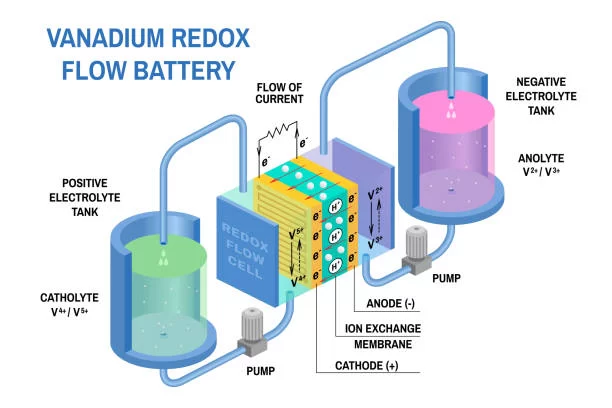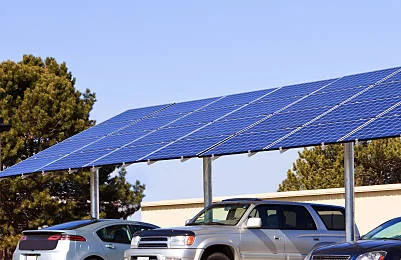Carport Photovoltaic Power Generation System: Empowering Green Travel for New Energy Vehicles
In today’s pursuit of sustainable development, carport photovoltaic (PV) power generation systems are emerging as an innovative solution. They not only provide shelter for our vehicles but also harness solar energy to generate electricity, offering numerous benefits to our lives.
1. Working Principle of Carport Photovoltaic Power Generation System
The carport PV power generation system primarily consists of solar panels, inverters, energy storage devices, support structures, and charging facilities. Solar panels installed on the roof of the carport convert sunlight into direct current (DC) electricity. The inverter then transforms the DC electricity into alternating current (AC), making it suitable for residential or commercial use. Energy storage devices provide backup power when sunlight is insufficient, ensuring a stable electricity supply.
2. Advantages of Carport Photovoltaic Power Generation System
Environmentally Friendly and Energy-Saving
By utilizing solar energy, the system generates electricity without producing pollutants or greenhouse gases, making it a truly green energy source. Compared to traditional fossil fuels, photovoltaic power generation significantly reduces environmental impact.
Cost-Effective
While the initial investment for a carport PV power generation system may be high, it offers substantial savings on electricity costs in the long run. Additionally, in some regions, government subsidies and tax incentives further reduce the overall expense.
Versatility
Carport PV systems provide shade and protection from rain for vehicles while also supplying electricity to households or commercial facilities. In certain cases, surplus electricity can be sold back to the grid, generating additional income for users.
High Reliability
Solar energy is an inexhaustible resource, and as long as there is sunlight, the system can operate continuously. Moreover, PV systems have relatively low maintenance costs and long lifespans, making them highly dependable.
3. Installation and Maintenance of Carport Photovoltaic Power Generation Systems
Installation
The installation of a carport PV system requires professional technicians. Before installation, the carport’s structure and load capacity must be evaluated to ensure safety and reliability. During the installation process, attention must be paid to the angle and orientation of the solar panels to maximize power generation efficiency.
Maintenance
Maintaining a carport PV system is relatively straightforward. Regular cleaning of solar panels is necessary to ensure their surfaces remain free of debris, thus enhancing efficiency. Additionally, the operational status of inverters and energy storage devices should be inspected periodically. Any faults or issues should be promptly addressed by qualified technicians.
4. Application Cases of Carport Photovoltaic Power Generation Systems
Residential Applications
Many households choose to install carport PV systems over their garages or parking spaces to partially or fully meet their electricity needs. This not only reduces utility bills but also contributes to environmental protection.
Commercial Applications
Commercial facilities such as parking lots, shopping centers, and factories are increasingly adopting carport PV systems. These systems not only supply electricity to commercial establishments but also facilitate electric vehicle (EV) charging.
Public Facilities
Carport PV systems are also being applied to public facilities such as schools, hospitals, and parks. They provide power to public infrastructure, reduce reliance on traditional energy sources, and create a green and sustainable living environment for citizens.
5. Future Trends in Carport Photovoltaic Power Generation Systems
With continuous technological advancements and declining costs, the application prospects for carport PV systems are becoming increasingly promising. In the future, we can anticipate more innovative applications and solutions, such as smart carports and solar-powered charging stations. Simultaneously, governments are expected to further enhance support for renewable energy, driving the widespread adoption and development of carport PV systems.
In conclusion, carport photovoltaic power generation systems represent a green energy solution with immense potential. They not only provide shelter for vehicles but also deliver clean and reliable electricity for our daily lives. Moving forward, we should actively promote and adopt carport PV systems to contribute to achieving the goals of sustainable development.

4. Sodium-Sulfur Batteries: Dominated by Foreign Technology, Domestic Challenges Persist
Sodium-sulfur batteries have high energy storage capacity, stable operation, minimal maintenance requirements, and a cycle life of over 4000 cycles. They also have over a decade of proven operational performance. However, these batteries require a high operating temperature of 300℃-350℃, which poses certain safety risks.
While sodium-sulfur batteries have matured abroad, with over 200 storage plants built globally—second only to lithium-ion batteries—the technology remains monopolized by Japan’s NGK. This company leads globally in sodium-sulfur battery system development and is the only enterprise capable of large-scale commercial production. In contrast, China’s research and development in this field started late, making short-term commercial promotion challenging.
Each energy storage battery technology has its strengths and weaknesses. Lead-carbon batteries offer high cost-performance in the short term, making them suitable for applications sensitive to costs but not demanding deep discharge or high-power output. Lithium-ion batteries, with their scale advantages and secondary use potential, are the frontrunners in energy storage, offering broad application scenarios. Vanadium redox flow batteries, with their long cycle life, are ideal for large-scale energy storage despite high initial costs and operational challenges. Sodium-sulfur batteries boast high performance but face constraints from high operating temperatures and foreign monopolization.
In the future, energy storage development will require careful consideration of these factors to select the most suitable battery technology for specific needs. Meanwhile, continued advancements and breakthroughs in research and application are anticipated to drive the energy storage industry toward greater innovation and growth.

